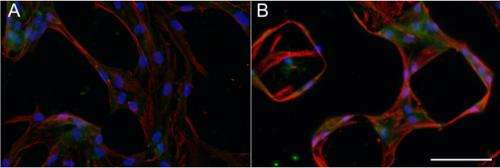New methods help to improve attachment of an implant to bone

Replacement of prostheses is unpleasant to the patient and expensive to society. Replacement of failed hip prostheses gives rise to an expenditure of about 10 million euros yearly in Finland. A usual reason for the need to change a prosthesis is its becoming detached from bone. A recent doctoral dissertation at Aalto University has come across several methods with which the adhesion of implants to bone can be improved.
'The osseointegration of an implant is often problematic because soft tissue, not the bone tissue directly, surrounds the implant. This kind of solution can never be permanent: when the implant is subjected to stress, rapid bone loss ensues, after which the attachment of the implant will fail,' Emilia Kaivosoja, the doctoral candidate, tells.
Cells can be affected by substances, physical forces and hormones
For implant integration, it is important that cells adhere to the surface of the implant as this promotes bone formation or differentiation of progenitor stem cells to bone cells. The research found that when the surface of the silicon used in implants was patterned with various materials (diamond-like carbon, chromium, tantalum, or titanium) its biocompatibility with bone cells and stem cells was improved.
The research also dealt with three-dimensional surfaces intended to support three-dimensional growth of the cells and activation of the cytoskeleton, which have been found to promote bone formation (osteogenesis) in earlier research. Now it was found that activation of the cytoskeleton alone is not sufficient for osteogenesis.
In addition to being affected by substances, cells can be affected by physical forces and hormones. The research showed that pulsed electromagnetic fields improve cell survival. It was found that also dehydroepiandrosterone, a sex steroid prohormone, promotes osteogenesis. By combining these two treatments into a two-stage therapy, it may be possible to help patients who suffer from illnesses such as osteoporosis that can negatively affect the adhesion of an implant.
Implant integration and its lifetime are also affected by their contact with normal microbes and pathogens. In the dissertation, it was pointed out that with time-of-flight secondary ion mass spectrometry (ToF-SIMS) bacteria on the surface of implant material can be detected.
Emilia Kaivosoja's dissertation defence takes place in Aalto University School of Electrical Engineering on Friday 15 March 2013 at 12 noon. The title of the thesis is "Improvement of osseointegration".
















